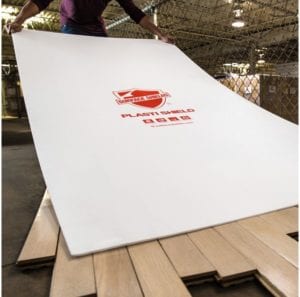Floor protection during construction gives everyone peace of mind. Using protective material on the worksite means that the crew can focus on the task at hand rather than worrying about damaging floors, cabinetry, countertops, or other surfaces.
Even if the flooring (or other surface material) is inexpensive, you must also consider labor costs for installation. Paying to replace damaged material plus labor is not an expense you want your business to experience if you can avoid it!
Although surface protection might raise your costs a bit, it helps to think of it as a type of insurance that protects your wallet, your schedule, and your reputation.
Considerations When Choosing Floor Protection
 Before you can choose construction floor protection, you obviously have to know what you’re protecting. Nearly every type of flooring and decorative surface material needs protection:
Before you can choose construction floor protection, you obviously have to know what you’re protecting. Nearly every type of flooring and decorative surface material needs protection:
- Carpet
- Granite
- Laminate
- Marble
- Stone
- Tile
- Vinyl
- Wood
Equally important to know is what you’re protecting against:
Dents
Dents can occur when a heavy tool is dropped onto a surface. Pushing a heavy dolly or cart across a surface can also dent materials.
Cracks
Harder materials like ceramic or stone tile are vulnerable to cracking from heavy objects that either fall or are moved across it.
Spills
Chemicals (including paint) that are spilled or splattered at the worksite can damage flooring beyond repair. Even water can cause damage, such as to wood flooring.
Scratches
Scratches can be caused when grit gets trapped under a moving object like a dolly or when tools and equipment are carelessly handled.
Scorches
If your worksite uses welding tools or blow torches, scorches can damage even the hardest materials.
Wrinkling
Carpets can become wrinkled if heavy objects are dragged or rolled across it.
Another important consideration when choosing construction floor protection is the length of time it’s needed. In general, you can tell by the thickness of the protective material whether it will endure a longer project. However, some thinner material can be quite durable, so ask a floor protection specialist if you’re unsure.
5 Methods for Maximum Floor Protection
Follow this checklist for floor protection during construction to guard against the most common forms of damage to floors and other surfaces.
Plan What Needs to Be Protected
Look over the worksite and determine three things:
- What needs to be covered and protected — Make sure you think this through for every stage of the construction or renovation project.
- What areas need to be sealed off — You can protect floors completely by blocking access with construction tape or safety netting/mesh.
- How long it needs protection — The length of time you plan to be on the project for affects the type and durability of flooring protection needed.
Use Tape to Prevent Falls
Tape the edges of protective materials together to keep them from curling up and posing a tripping hazard. You should also ensure that the material doesn’t slide across the floor, which can damage the flooring beneath or cause a fall.
Determine Hauling Methods
Before starting the project, decide which types of dollies or carts you will allow inside the worksite. Having four-wheeled transport is better than two-wheeled, as the weight is distributed better and less likely to damage floors. For the same reason, wider wheels are better than thinner wheels.
Clean Floors and Other Surfaces
Before installing floor or surface protection, carefully sweep or vacuum up debris. If the surface has any sort of spill that’s dried on it, wipe it up so it doesn’t get sealed under the protective material and cause damage.
Buy Protective Material
Based on the flooring you will be installing as well as any other surfaces that need protection, purchase the material that best fits the project requirements. In general, protective material is made of:
- Corrugated cardboard
- Corrugated plastic
- Hardboard
- Plastic film, sheets, rolls, or mats
- Rolled paper
- Rubber sheets
You can also find a wide variety of protective material that uses different materials bonded together, such as rosin paper, fiberglass, and polyethylene.
Plasti-Shield Benefits
One type of material that can protect a variety of surfaces is Plasti-Shield™ from Surface Shields. Plasti-Shield is a type of corrugated plastic that’s lightweight, but also strong, durable, and impact resistant. Its many benefits include:
- Available with a fire-retardant additive
- Cost-effective
- Cuts easily with a utility knife
- Reusable to help cut construction costs
- Water and chemical resistant
Installation is simple, as all that’s needed to seam the edges together is blue tape.
Flooring Protection Help and Quotes
Starting a new construction or renovation project without having floor/surface protection on hand can lead to damaged material and higher labor costs. But with the right planning and the practical steps mentioned in this article, you’ll be covered (pun intended)!
Whether you’re interested in Plasti-Shield™ from Surface Shield or want to look into a variety of surface protection materials, The Pro Group is happy to answer any questions or give you a quote.



